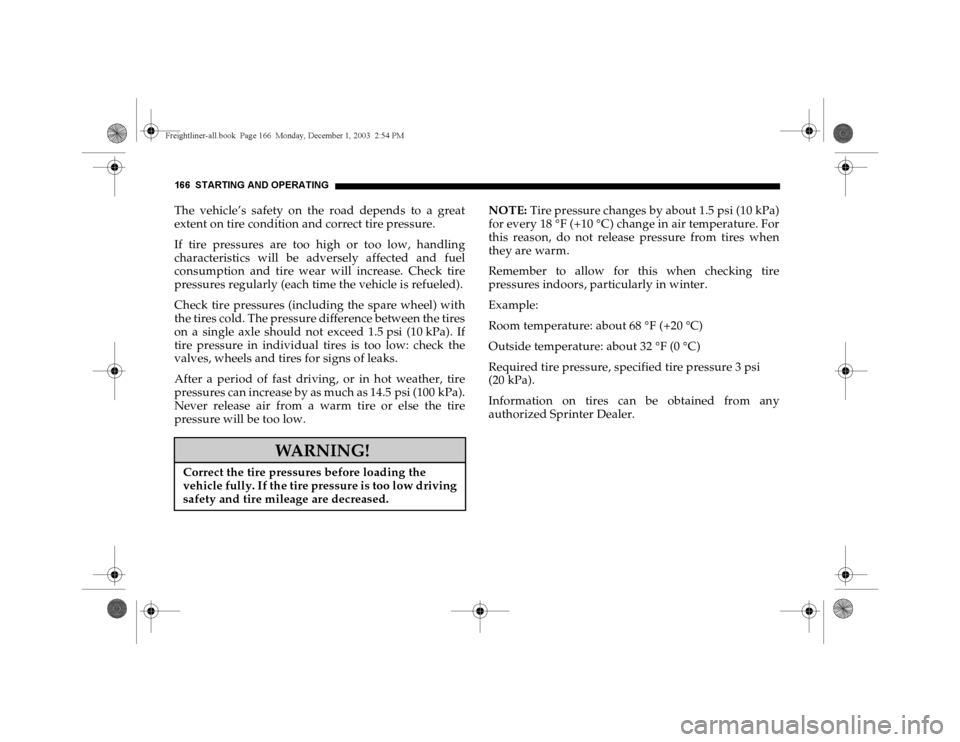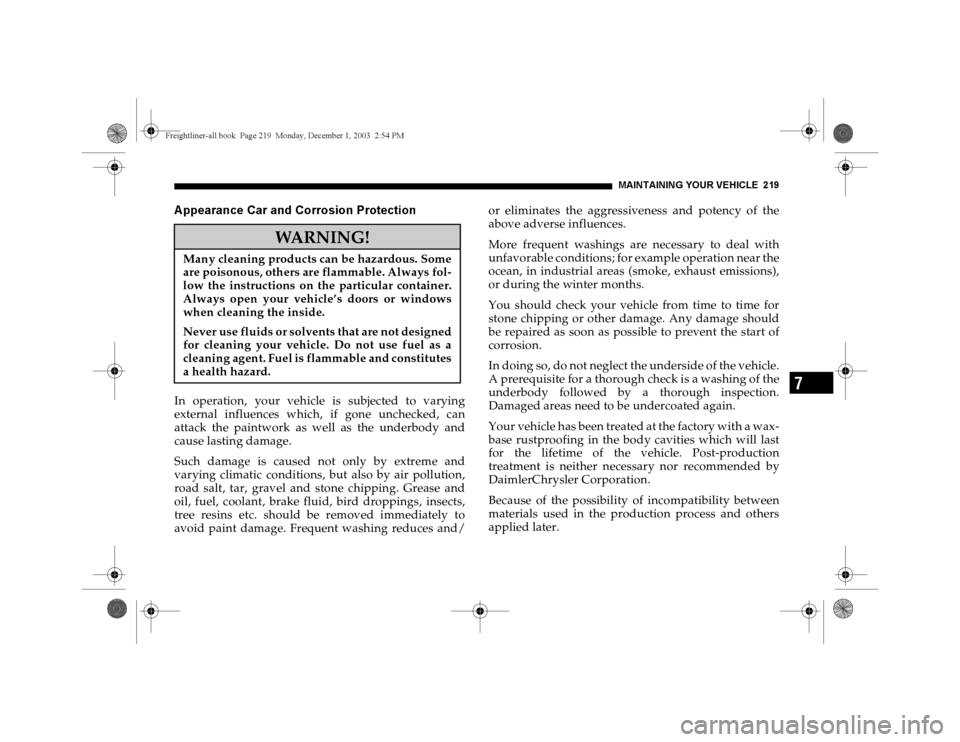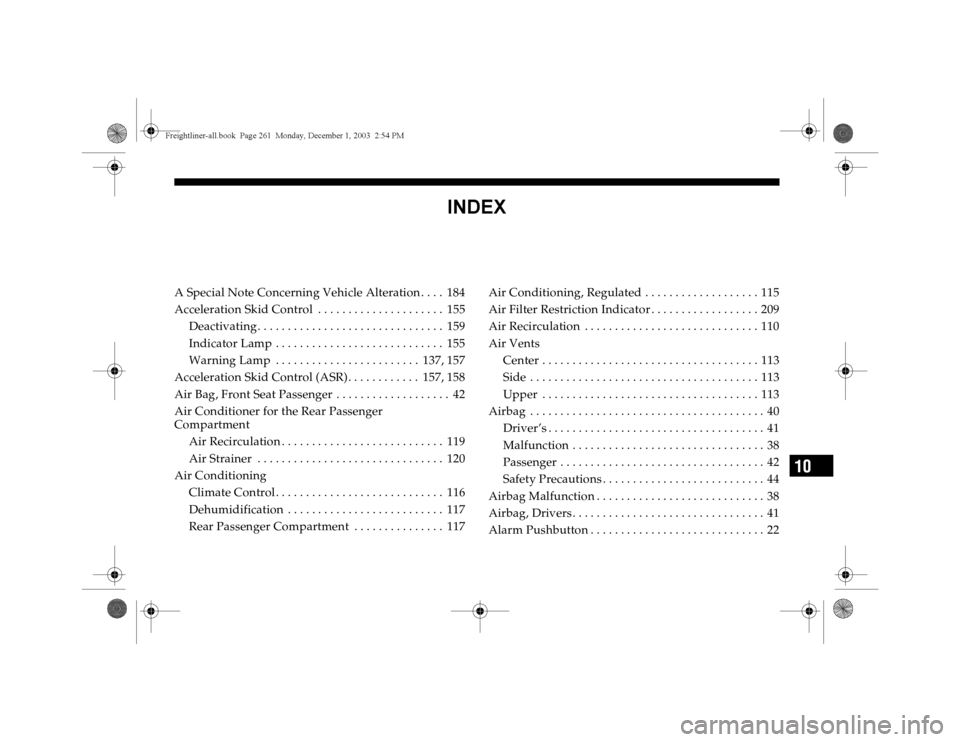2004 DODGE SPRINTER air condition
[x] Cancel search: air conditionPage 166 of 272

166 STARTING AND OPERATINGThe vehicle’s safety on the road depends to a great
extent on tire condition and correct tire pressure.
If tire pressures are too high or too low, handling
characteristics will be adversely affected and fuel
consumption and tire wear will increase. Check tire
pressures regularly (each time the vehicle is refueled).
Check tire pressures (including the spare wheel) with
the tires cold. The pressure difference between the tires
on a single axle should not exceed 1.5 psi (10 kPa). If
tire pressure in individual tires is too low: check the
valves, wheels and tires for signs of leaks.
After a period of fast driving, or in hot weather, tire
pressures can increase by as much as 14.5 psi (100 kPa).
Never release air from a warm tire or else the tire
pressure will be too low.NOTE: Tire pressure changes by about 1.5 psi (10 kPa)
for every 18
°F (+10
°C) change in air temperature. For
this reason, do not release pressure from tires when
they are warm.
Remember to allow for this when checking tire
pressures indoors, particularly in winter.
Example:
Room temperature: about 68
°F (+20
°C)
Outside temperature: about 32
°F (0
°C)
Required tire pressure, specified tire pressure 3 psi
(20 kPa).
Information on tires can be obtained from any
authorized Sprinter Dealer.
WARNING!
Correct the tire pressures before loading the
vehicle fully. If the tire pressure is too low driving
safety and tire mileage are decreased.
Freightliner-all.book Pag e 166 Monday, December 1, 2003 2:54 PM
Page 181 of 272

STARTING AND OPERATING 181
5
WARNING!
Take into consideration that when towing a trail-
er, the handling characteristics are different and
less stable from those when operating the vehicle
without a trailer.
It is important to avoid sudden maneuvers.
Sudden maneuvers may lead to loss of control
over the vehicle-trailer combination. This could
cause an accident resulting in property damage or
injury to you or others.
CAUTION!
If the transmission hunts between gears on
inclines, manually shift to a lower gear (select
"4",
"3", "2" or
"1"). A lower gear and reduction of
speed reduces the chance of engine overloading
and / or overheating.
When going down a long hill, shift into a lower
gear and use the engine’s braking effect. Avoid
riding the brakes, thus overheating the vehicle
and trailer brakes.
If the engine coolant rises to an extremely high
temperature (coolant temperature needle
approaching the red zone) when the air
conditioner is on, turn off the air conditioner.
Engine coolant heat can be additionally vented by
opening the windows, switching the climate
control fan speed to high and setting the
temperature control to the maximum hot position.
Freightliner-all.book Pag e 181 Monday, December 1, 2003 2:54 PM
Page 208 of 272

208 MAINTAINING YOUR VEHICLEDisposal of Service ProductsDispose of service products and of parts which come
into contact with them (e.g. filters) in an
environmentally responsible manner. Comply with
applicable bars and regulations.EMISSION RELA TED COMPONENT WA RRA NTY
STATEMENTThe Manufacturer warrants to the original and each
subsequent owner of a MERCEDES-BENZ heavy-duty
on highway diesel engine that:
(1) the engine was designed, built and equipped so as
to conform at the time of sale with the applicable
regulations adopted by the Federal Environmental
Protection Agency
(2) the emission control system of such engine is free
from defects in materials and workmanship which
would cause it not to conform with those regulations
for a period of use of five years or 100 000 miles or
3 000 hours of engine operation, whichever occurs
first.
REGULA R CHECKSThe following checks should be performed at regular
intervals (for example once a week or each time the
vehicle is refueled):
Windshield cleaner system – fluid reservoir.
Air strainer, in vehicles with an air strainer element
maintenance indicator (optional equipment).
Engine oil level.
Checking ribbed V-belt.
Hydraulic brake system, clutch mechanism fluid
level.
Coolant level.
Tire and spare wheel condition and pressures of the
same. For more information, refer to "Wheels and
Tires".
Vehicle lighting.
Freightliner-all.book Pag e 208 Monday, December 1, 2003 2:54 PM
Page 219 of 272

MAINTAININ G YOUR VEHICLE 219
7
A ppearance Car and Corrosion ProtectionIn operation, your vehicle is subjected to varying
external influences which, if gone unchecked, can
attack the paintwork as well as the underbody and
cause lasting damage.
Such damage is caused not only by extreme and
varying climatic conditions, but also by air pollution,
road salt, tar, gravel and stone chipping. Grease and
oil, fuel, coolant, brake fluid, bird droppings, insects,
tree resins etc. should be removed immediately to
avoid paint damage. Frequent washing reduces and/or eliminates the aggressiveness and potency of the
above adverse influences.
More frequent washings are necessary to deal with
unfavorable conditions; for example operation near the
ocean, in industrial areas (smoke, exhaust emissions),
or during the winter months.
You should check your vehicle from time to time for
stone chipping or other damage. Any damage should
be repaired as soon as possible to prevent the start of
corrosion.
In doing so, do not neglect the underside of the vehicle.
A prerequisite for a thorough check is a washing of the
underbody followed by a thorough inspection.
Damaged areas need to be undercoated again.
Your vehicle has been treated at the factory with a wax-
base rustproofing in the body cavities which will last
for the lifetime of the vehicle. Post-production
treatment is neither necessary nor recommended by
DaimlerChrysler Corporation.
Because of the possibility of incompatibility between
materials used in the production process and others
applied later.
WARNING!
Many cleaning products can be hazardous. Some
are poisonous, others are flammable. Always fol-
low the instructions on the particular container.
Always open your vehicle’s doors or windows
when cleaning the inside.
Never use fluids or solvents that are not designed
for cleaning your vehicle. Do not use fuel as a
cleaning agent. Fuel is flammable and constitutes
a health hazard.
Freightliner-all.book Pag e 219 Monday, December 1, 2003 2:54 PM
Page 221 of 272

MAINTAININ G YOUR VEHICLE 221
7
A utomatic Car WashIf the vehicle is very dirty, prewash it before you drive
into the car wash.
Fold in the exterior mirrors before washing the vehicle
in an automatic car wash and make sure that the
windshield wiper switch is in position 0.
The exterior mirrors and windshield wipers could
otherwise be damaged.
Make sure that mirrors are fully folded out after
leaving the automatic car wash.
Tar StainsQuickly remove tar stains before they dry and become
more difficult to remove. A tar remover is
recommended.Paintwork, Painted Body ComponentsPaint care should be applied when water drops on the
paint surface do not "bead up", normally every 3 to
5 months, depending on climate and washing
detergent used.
Paint cleaner should be applied if paint surface shows
signs of dirt embedding (i.e. loss of gloss).
Do not apply any of these products or wax if your
vehicle is parked in the sun or if the hood is still hot.
Use the appropriate paint stick for quick and
provisional repairs of minor paint damage (i.e., chips
from stones, vehicle doors etc.).Engine Cleaning Prior to cleaning the engine compartment, make sure
to protect electrical components and connectors from
the intrusion of water and cleaning agents.
WARNING!
Smears impair visibility, which is impaired fur-
ther by unfavourable conditions (e.g. fog, dark-
ness, driving snow).
If a wax preservative is sprayed on after washing
the vehicle, wipe off the wax from the windshield
and the wiper blade rubbers. This will prevent
smears forming on the windshield.
Freightliner-all.book Pag e 221 Monday, December 1, 2003 2:54 PM
Page 251 of 272

MAINTENANCE SCHEDULES 251
8M
A
I
N
T
E
N
A
N
C
E
S
C
H
E
D
U
L
E
S
SPECIAL MAINTENANCE REQUIREMENTSIf bodies built by manufacturers other than
DaimlerChrysler Corporation are fitted to the vehicle, the
maintenance requirements and lubrication intervals
specified by the body manufacturer must be adhered to,
in addition to all standard maintenance requirements.Brake FluidOnly use brake fluids approved by the manufacturer
(DOT 4 plus). Information about brake fluids is
available from your Sprinter Dealer.CoolantHave the corrosion inhibitor/antifreeze concentration
in the coolant checked before the onset of winter (once
a year in countries with high prevailing temperatures).
Have the coolant renewed every five years or 100,000
miles.Dust Filter for Heating/Ventilation ReplacementThe dust filter and the tailgate interior filter are
renewed during routine maintenance service.
However, if operating conditions are dusty, these
filters should be renewed more frequently.
ENGINE OIL CHA NGE A ND FILTER
REPLACEMENTIn a minimum, change the engine oil and oil filter once
a year - even if the vehicle mileage per year is extremly
low. For standard oil service schedules, please see the
chapter oil service and maintenance service.Once a YearSelect the viscosity of the engine oil (SAE classes)
according to the outside air temperature.
Only use engine oil approved by DaimlerChrysler
Corporation if following the ASSYST system
guidelines.
Information is available from your Sprinter Dealer.
If the fuel used has a sulphur content exceeding 0.05 %
by weight, the service intervals should be split in half.
If the sulphur content of the fuel used is between 0.3%
and 0.8% by weight, the service intervals should be
split in half (i.e. every 5,000 miles instead of every
10,000 miles).
Freightliner-all.book Pag e 251 Monday, December 1, 2003 2:54 PM
Page 253 of 272

MAINTENANCE SCHEDULES 253
8M
A
I
N
T
E
N
A
N
C
E
S
C
H
E
D
U
L
E
S
Check fluid levels for the following systems, correct
as necessary.
Should there be a loss of fluid which cannot be
explained by regular use, trace and eliminate
the cause.
Engine cooling system
Check corrosion inhibitor/antifreeze,
refill as necessary.
Hydraulic brake system
Battery
Windscreen washer system
Engine
Fuel filter renewal
Air cleaner with maintenance indicator:
Check degree of contamination.
Air cleaner filter element renewed as
necessary.Chassis and body
Trailer coupling:
Check operation, play and retaining fixtures
Secondary rubber springs:
Visual check
Tire pressures:
Correct as necessary, including spare tyre
Check thickness of brake pads
Brake test
Check condition of brake disks. Brake disks renewal as
necessary
– as a separate order
Check condition of steering mechanism
Heating/ventilation dust filter renewal
Freightliner-all.book Pag e 253 Monday, December 1, 2003 2:54 PM
Page 261 of 272

INDEX
10
A Special Note Concerning Vehicle Alteration . . . . 184
Acceleration Skid Control . . . . . . . . . . . . . . . . . . . . . 155
Deactivating . . . . . . . . . . . . . . . . . . . . . . . . . . . . . . . 159
Indicator Lamp . . . . . . . . . . . . . . . . . . . . . . . . . . . . 155
Warning Lamp . . . . . . . . . . . . . . . . . . . . . . . . 137, 157
Acceleration Skid Control (ASR). . . . . . . . . . . . 157, 158
Air Bag, Front Seat Passenger . . . . . . . . . . . . . . . . . . . 42
Air Conditioner for the Rear Passenger
Compartment
Air Recirculation . . . . . . . . . . . . . . . . . . . . . . . . . . . 119
Air Strainer . . . . . . . . . . . . . . . . . . . . . . . . . . . . . . . 120
Air Conditioning
Climate Control . . . . . . . . . . . . . . . . . . . . . . . . . . . . 116
Dehumidification . . . . . . . . . . . . . . . . . . . . . . . . . . 117
Rear Passenger Compartment . . . . . . . . . . . . . . . 117Air Conditioning, Regulated . . . . . . . . . . . . . . . . . . . 115
Air Filter Restriction Indicator . . . . . . . . . . . . . . . . . . 209
Air Recirculation . . . . . . . . . . . . . . . . . . . . . . . . . . . . . 110
Air Vents
Center . . . . . . . . . . . . . . . . . . . . . . . . . . . . . . . . . . . . 113
Side . . . . . . . . . . . . . . . . . . . . . . . . . . . . . . . . . . . . . . 113
Upper . . . . . . . . . . . . . . . . . . . . . . . . . . . . . . . . . . . . 113
Airbag . . . . . . . . . . . . . . . . . . . . . . . . . . . . . . . . . . . . . . . 40
Driver’s . . . . . . . . . . . . . . . . . . . . . . . . . . . . . . . . . . . . 41
Malfunction . . . . . . . . . . . . . . . . . . . . . . . . . . . . . . . . 38
Passenger . . . . . . . . . . . . . . . . . . . . . . . . . . . . . . . . . . 42
Safety Precautions . . . . . . . . . . . . . . . . . . . . . . . . . . . 44
Airbag Malfunction . . . . . . . . . . . . . . . . . . . . . . . . . . . . 38
Airbag, Drivers . . . . . . . . . . . . . . . . . . . . . . . . . . . . . . . . 41
Alarm Pushbutton . . . . . . . . . . . . . . . . . . . . . . . . . . . . . 22Freightliner-all.book Pag e 261 Monday, December 1, 2003 2:54 PM